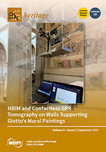 |
António João Cruz, Helena P. Melo, Sara Valadas, Catarina Miguel, António Candeias, "The matter from which an orange colour is made: on the arsenic pigment used in a portuguese mannerist painting", Heritage, 5(3), 2022, pp. 2646-2660, doi:10.3390/heritage5030138 |
| Abstract |
The painting The Descent from the Cross, painted in 1620 by Pedro Nunes (1586–1637), presents two large figures with orange-coloured fabrics with conservation problems. Through the analysis of two samples with several analytical techniques, especially scanning electron microscopy combined with X-ray spectroscopy and Raman microscopy, it was possible to conclude that the orange colour is due to a complex artificial pigment made of amorphous arsenic sulphide. It essentially consists of spherical particles obtained by sublimation and condensation, possibly from orpiment, which ended up being joined with irregularly shaped particles resulting from crushing of the residual fraction obtained by solidification and fusion. This is a rare documented case of the extensive use of artificial arsenic sulphides in European easel painting, especially outside Italy. The conservation problems can be explained by the great sensitivity of the arsenic sulphides to photodegradation and the formation of powdery compounds |
